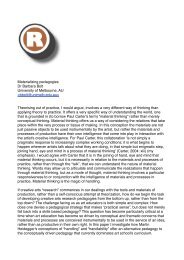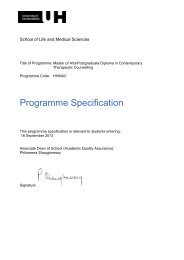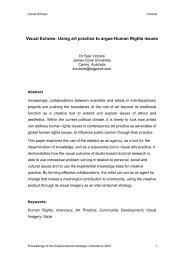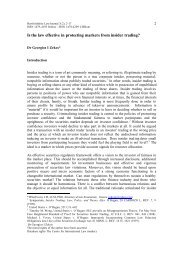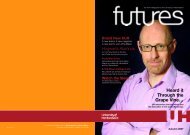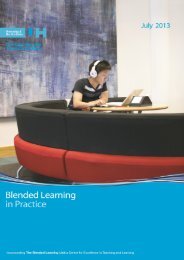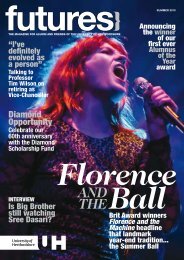The role of the art object in contemporary art - University of ...
The role of the art object in contemporary art - University of ...
The role of the art object in contemporary art - University of ...
Create successful ePaper yourself
Turn your PDF publications into a flip-book with our unique Google optimized e-Paper software.
<strong>The</strong> <strong>role</strong> <strong>of</strong> <strong>the</strong> <strong>art</strong> <strong>object</strong> <strong>in</strong> <strong>contemporary</strong> <strong>art</strong>Abigail DiamondNott<strong>in</strong>gham Trent <strong>University</strong>, EnglandIntroductionIf we consider <strong>the</strong> <strong>role</strong> <strong>of</strong> <strong>the</strong> <strong>art</strong> <strong>object</strong> <strong>in</strong> <strong>contemporary</strong> <strong>art</strong> <strong>the</strong>re seems to be a confus<strong>in</strong>gparadox. <strong>The</strong> <strong>art</strong> historian Charles Harrison states <strong>in</strong> 'Art <strong>in</strong> <strong>The</strong>ory' that <strong>the</strong> anthology betreated not solely as a resource to study <strong>art</strong> but that it be accompanied by 'first-handexperience <strong>of</strong> modern <strong>art</strong>' (Harrison, 1992). David Davies also stresses <strong>the</strong> importance <strong>of</strong>a 'direct experiential encounter with an <strong>in</strong>stance <strong>of</strong> a work' (Davies, 2003). Yet despite thisstress on <strong>the</strong> direct experience <strong>of</strong> <strong>art</strong>works it seems that, as noted by Vickery, <strong>the</strong>conceptual or hermeneutic aspects <strong>of</strong> <strong>art</strong> seem to be those which are most valued with<strong>in</strong><strong>the</strong> <strong>contemporary</strong> <strong>art</strong>world (Vickery, 2004). This paper will <strong>the</strong>refore explore <strong>the</strong> <strong>role</strong> <strong>of</strong> <strong>the</strong><strong>art</strong> <strong>object</strong> <strong>in</strong> <strong>contemporary</strong> <strong>art</strong>, and <strong>in</strong> so do<strong>in</strong>g beg<strong>in</strong> to address <strong>the</strong> conference questions;what differentiates <strong>art</strong>efact-based transactions from l<strong>in</strong>guistic ones? Do <strong>art</strong>efacts merelystimulate l<strong>in</strong>guistic reason<strong>in</strong>g? Can an <strong>art</strong>efact do more than simply illustrate a concept?and ultimately, what is <strong>the</strong> <strong>role</strong> <strong>of</strong> <strong>the</strong> <strong>art</strong>efact <strong>in</strong> <strong>art</strong> and design research?In order to achieve this <strong>the</strong> paper will draw upon a number <strong>of</strong> <strong>in</strong>terviews conducted as p<strong>art</strong><strong>of</strong> my PhD research project. <strong>The</strong>se <strong>in</strong>clude <strong>in</strong>terviews with an <strong>art</strong> historian anon2, a critic,an <strong>art</strong>s journalist, an <strong>art</strong> journal editor anon4, a curator and a number <strong>of</strong> <strong>contemporary</strong><strong>art</strong>ists anon1, anon3.<strong>The</strong> Art ObjectI will beg<strong>in</strong> by explor<strong>in</strong>g <strong>the</strong> <strong>role</strong> <strong>of</strong> <strong>the</strong> <strong>art</strong> <strong>object</strong> <strong>in</strong> <strong>the</strong> <strong>contemporary</strong> <strong>art</strong>world. <strong>The</strong> <strong>in</strong>itial<strong>in</strong>terviews conducted as p<strong>art</strong> <strong>of</strong> this research were <strong>in</strong> retrospect approached with anunderstand<strong>in</strong>g not dissimilar to what David Davies terms <strong>the</strong> 'common-sense' approach tounderstand<strong>in</strong>g <strong>art</strong> and <strong>art</strong> <strong>the</strong>ory. In this approach <strong>the</strong> belief is that it is 'necessary andsufficient' to have a direct experiential encounter with <strong>art</strong>. Such an encounter is 'necessarybecause <strong>the</strong>re are appreciable properties bear<strong>in</strong>g on <strong>the</strong> dist<strong>in</strong>ctive value <strong>of</strong> a work thatare graspable only <strong>in</strong> such an experience' (Davies, 2003). It is sufficient <strong>in</strong> that 'anyproperties <strong>of</strong> <strong>the</strong> work not graspable <strong>in</strong> an experiential encounter with <strong>the</strong> work have nobear<strong>in</strong>g on a works <strong>art</strong>istic value' (Davies, 2003). <strong>The</strong> belief is that <strong>art</strong>works posses
properties and knowledge 'accessible to receivers who engage <strong>in</strong> such direct experientialencounters' with <strong>the</strong>m and that we may characterise such experiences as'aes<strong>the</strong>tic' (Davies, 2003). In a recent paper Charles Harrison explored 'Modernism'ssupposed disestablishment <strong>in</strong> <strong>the</strong> transatlantic <strong>art</strong>world <strong>of</strong> <strong>the</strong> late 1960's and early 1970's'and <strong>in</strong> so do<strong>in</strong>g quoted a number <strong>of</strong> people who had <strong>of</strong>fered similar views <strong>of</strong> <strong>the</strong>experience <strong>of</strong> <strong>the</strong> work <strong>of</strong> <strong>art</strong> (Harrison, 2004). He referred to Bell, who stated that 'Toappreciate fully a work <strong>of</strong> <strong>art</strong> we require noth<strong>in</strong>g but sensibility. To those that can hear <strong>art</strong>speaks for itself' and to Greenberg, who commented that 'Aes<strong>the</strong>tic judgement co<strong>in</strong>cideswith <strong>the</strong> immediate experience <strong>of</strong> <strong>art</strong>; it is not arrived at afterwards through reflection orthought' (Greenberg, 1967).If we consider <strong>the</strong>se statements and believe that <strong>art</strong>works are 'dist<strong>in</strong>guished by <strong>the</strong>iraes<strong>the</strong>tic properties conferred on <strong>the</strong>m by <strong>the</strong>ir creators' it would seem logical to followAndrew Harrison's argument from <strong>the</strong> last 'Research Into Practice' conference <strong>in</strong> which heconsidered that we might need to view <strong>art</strong>works as '<strong>object</strong>s <strong>of</strong> knowledge <strong>in</strong> <strong>the</strong>ir ownright' (Harrison, 2002). Similarly, it seemed appropriate to use <strong>the</strong> <strong>art</strong>ists <strong>in</strong>terviews I wasconduct<strong>in</strong>g to probe <strong>art</strong>ists' <strong>in</strong>tentions, as a means <strong>of</strong> elucidat<strong>in</strong>g <strong>in</strong>sights <strong>in</strong>to <strong>the</strong> <strong>role</strong> <strong>of</strong><strong>the</strong> <strong>art</strong> <strong>object</strong> and its support<strong>in</strong>g <strong>the</strong>ory. It was on this basis and this progression <strong>of</strong> thoughtthat led me to write <strong>the</strong> abstract and propose a paper for this conference.However, s<strong>in</strong>ce writ<strong>in</strong>g <strong>the</strong> abstract for this paper it has become apparent that my th<strong>in</strong>k<strong>in</strong>gon <strong>the</strong> <strong>role</strong> <strong>of</strong> <strong>the</strong> <strong>art</strong> <strong>object</strong>, with<strong>in</strong> <strong>contemporary</strong> <strong>art</strong> at least, has changed. Despite stillbeliev<strong>in</strong>g that <strong>in</strong> o<strong>the</strong>rs areas <strong>of</strong> <strong>art</strong> and design, such as textiles for example, <strong>the</strong> result<strong>in</strong>g<strong>object</strong> as an outcome <strong>of</strong> practice can be seen to evidence research <strong>in</strong> <strong>the</strong> field, I amunsure if I any longer agree that <strong>the</strong> same could, or should, be said for f<strong>in</strong>e <strong>art</strong>. I will usethis paper to outl<strong>in</strong>e my reason<strong>in</strong>g beh<strong>in</strong>d this th<strong>in</strong>k<strong>in</strong>g.Someth<strong>in</strong>g that came to light recently and affected my th<strong>in</strong>k<strong>in</strong>g was <strong>the</strong> awareness that <strong>the</strong><strong>art</strong>ists I <strong>in</strong>terviewed did not see <strong>the</strong>ir work as an embodiment <strong>of</strong> <strong>the</strong>ir ideas and <strong>in</strong>tentions.Instead <strong>the</strong>y described <strong>the</strong> <strong>art</strong> <strong>object</strong> as p<strong>art</strong> <strong>of</strong> <strong>the</strong> '<strong>art</strong>' but not <strong>the</strong> sum <strong>of</strong> it. <strong>The</strong>y felt <strong>the</strong>ywere not <strong>the</strong> authority on <strong>the</strong>ir own work and were <strong>in</strong> fact <strong>of</strong>ten not <strong>the</strong> best person to writeor speak about it. <strong>The</strong> work was described as reveal<strong>in</strong>g itself to <strong>the</strong>m as <strong>art</strong>ists just as itseemed to reveal itself to less familiar viewers. <strong>The</strong>se f<strong>in</strong>d<strong>in</strong>gs, and more recent <strong>in</strong>terviewsand texts have led me to review my position and consider <strong>the</strong> <strong>art</strong> <strong>object</strong> ra<strong>the</strong>r than anentity unto itself as someth<strong>in</strong>g <strong>in</strong>timately entw<strong>in</strong>ed <strong>in</strong> <strong>art</strong> as a social belief system andactivity.It seems discussions surround<strong>in</strong>g <strong>the</strong> <strong>role</strong> <strong>of</strong> <strong>the</strong> text <strong>in</strong> practice based f<strong>in</strong>e <strong>art</strong> PhDsubmissions <strong>of</strong>ten focus on understand<strong>in</strong>g how <strong>the</strong> <strong>art</strong>work may work. It is this questionthat also seems to be at <strong>the</strong> centre <strong>of</strong> <strong>the</strong> <strong>the</strong>mes <strong>of</strong> this conference, p<strong>art</strong>icularly whenconsider<strong>in</strong>g <strong>the</strong> difference between aes<strong>the</strong>tic and l<strong>in</strong>guistic communication.I do not believe we presently posses a means <strong>of</strong> understand<strong>in</strong>g <strong>the</strong> difference between<strong>art</strong>efact and l<strong>in</strong>guistic transactions. I see this as someth<strong>in</strong>g that would take a considerableamount <strong>of</strong> research, possibly from a cognitive psychology perspective, and I realise thatthis is someth<strong>in</strong>g that as a discipl<strong>in</strong>e we may be hostile to. I also feel that <strong>the</strong>re needs tobe a dist<strong>in</strong>ction made between <strong>art</strong>efact and <strong>art</strong> <strong>object</strong>, p<strong>art</strong>icularly <strong>the</strong> <strong>contemporary</strong> <strong>art</strong><strong>object</strong>.A recent television programme broadcast on Channel 4 on <strong>the</strong> 14th November 2004 gaveJake Chapman an opportunity to give his op<strong>in</strong>ions on <strong>the</strong> nature <strong>of</strong> <strong>contemporary</strong> <strong>art</strong>. <strong>The</strong>core idea seemed to be that <strong>the</strong> problem with <strong>contemporary</strong> <strong>art</strong> is that people seem to
elieve it is 'reducible to look<strong>in</strong>g', which he believes it is not, and that <strong>in</strong> fact it is 'noth<strong>in</strong>g todo with look<strong>in</strong>g, look<strong>in</strong>g is a very small p<strong>art</strong> <strong>of</strong> it, really it is to do with th<strong>in</strong>k<strong>in</strong>g' (Chapman,2003). An <strong>art</strong>icle by David Thompson <strong>in</strong> <strong>the</strong> Guardian on April 15th also quoted JakeChapman, as say<strong>in</strong>g that <strong>the</strong> <strong>in</strong>creas<strong>in</strong>g sensitivity shown by <strong>the</strong> galleries to a wideraudience for <strong>art</strong> could have a negative effect on '<strong>the</strong> potential for serious, discursive<strong>art</strong>' (Chapman, cited <strong>in</strong> Thompson, 2004).It is <strong>in</strong>sightful to know that Jake Chapman sees <strong>contemporary</strong> <strong>art</strong> as discursive. It alsoseems, as Jake suggests, that it is too easy to reduce <strong>the</strong> experience <strong>of</strong> <strong>the</strong> <strong>art</strong> <strong>object</strong> tolook<strong>in</strong>g. A recent <strong>in</strong>terview with an <strong>art</strong> journal editor anon4 suggested to me that forms <strong>of</strong>th<strong>in</strong>k<strong>in</strong>g about <strong>art</strong> 'can be entirely about discourse' or 'entirely about <strong>object</strong>s' and 'anyth<strong>in</strong>g<strong>in</strong> between'. anon4 believes that <strong>art</strong> is a 'discursive practice above all' and says <strong>the</strong>re is noproblem with that but fears that <strong>the</strong> <strong>in</strong>stitutions have. An example anon4 gave <strong>of</strong> <strong>art</strong>sdiscursive nature was that 'when you put a frame around a picture that picture is <strong>in</strong>dialogue with o<strong>the</strong>r pictures by <strong>the</strong> same <strong>art</strong>ist and o<strong>the</strong>r <strong>art</strong>ists, it's open ended'. Andanon4 does believe that <strong>the</strong> best <strong>art</strong> is open ended.Kosuth considers that <strong>in</strong> '<strong>art</strong> <strong>the</strong> means <strong>of</strong> expression is also not unlike language'. Heexemplifies this <strong>in</strong> this quote,Even accept<strong>in</strong>g <strong>the</strong> common view that <strong>art</strong>'s history goes beyond hundreds <strong>of</strong> years, it ispossible to see that <strong>the</strong> 'langugage' <strong>of</strong> <strong>the</strong> <strong>art</strong> <strong>of</strong> <strong>the</strong> west has been pa<strong>in</strong>t<strong>in</strong>g and sculpturefor some time. Up until <strong>the</strong> very recent past it has been assumed that if one wanted tospeak as an <strong>art</strong>ist he had to speak <strong>in</strong> <strong>the</strong> correct 'language'. That's how we knew he wasan <strong>art</strong>ist and what he made was <strong>art</strong> or meant to be <strong>art</strong>. Whatever was done, it had to bedone with<strong>in</strong> that language…<strong>in</strong> <strong>the</strong> past few years <strong>art</strong>ists have realised that <strong>the</strong>ir traditionallanguage is exhausted and unreal. (Kosuth, 1991:43)In Roy Harris's book '<strong>The</strong> necessity <strong>of</strong> Artspeak' Harris considers Kosuth's comments andconcludes that Kosuth shows;no <strong>in</strong>cl<strong>in</strong>ation to address <strong>the</strong> fundamental qualities <strong>of</strong> what makes language <strong>in</strong> <strong>the</strong>traditional sense a dist<strong>in</strong>ctive mode <strong>of</strong> communication and whe<strong>the</strong>r <strong>the</strong>se dist<strong>in</strong>ctiveproperties bear any conv<strong>in</strong>c<strong>in</strong>g relationship to those <strong>of</strong> pa<strong>in</strong>t<strong>in</strong>g and sculpture (Harris,2003: 130).Harris proceeds to criticise Kosuth's argument by say<strong>in</strong>g that his deployment <strong>of</strong> <strong>the</strong> notionthat <strong>art</strong> forms are 'languages' is typical and 'although <strong>in</strong>sistently repeated never advancesbeyond hackneyed metaphor' (Harris 2003, 129). Harris goes so far as to suggest thatalthough Kosuth 'makes reference to l<strong>in</strong>guists, <strong>in</strong>clud<strong>in</strong>g Saussure and Sapir, and even <strong>the</strong>Saussurean technical terms langue and pa<strong>role</strong>', such references tend to be both 'fleet<strong>in</strong>gand opaque' (Harris, 2003:129). Harris <strong>the</strong>refore suggests that whilst Kosuth's texts give<strong>the</strong> impression <strong>of</strong> 'engag<strong>in</strong>g with l<strong>in</strong>guistics <strong>in</strong> a serious way' <strong>the</strong>y are <strong>in</strong> fact 'vague<strong>the</strong>oretical gestures <strong>in</strong> a l<strong>in</strong>guistic direction, but noth<strong>in</strong>g more' (Harris, 2003:129).In a paper given at <strong>the</strong> 'Draw<strong>in</strong>g Discipl<strong>in</strong>ary L<strong>in</strong>es' conference <strong>in</strong> Leeds this May, CharlesHarrison described <strong>the</strong> situation he faced when as a young <strong>art</strong> journalist he found he was'no longer sure that <strong>the</strong> work itself had been responsible for (his) conviction <strong>of</strong> its value'.<strong>The</strong> work he was referr<strong>in</strong>g to was one <strong>of</strong> Morris Louis' 'bronze veil' pa<strong>in</strong>t<strong>in</strong>gs that he saw <strong>in</strong>Emmerich's gallery <strong>in</strong> New York <strong>in</strong> 1962.Harrison used this personal experience to reflecton <strong>the</strong> concerns he has about '<strong>the</strong> apparent decl<strong>in</strong>e <strong>in</strong> <strong>the</strong> status and potential <strong>of</strong> abstract
<strong>art</strong>', and with it '<strong>the</strong> emergence <strong>of</strong> an <strong>art</strong> that employed language as its medium' (Harrison,2004).<strong>The</strong>re exists a well-documented history <strong>of</strong> <strong>the</strong> dematerialisation <strong>of</strong> <strong>the</strong> <strong>art</strong> <strong>object</strong>, asconsidered by Lucy Lippard (1973). Yet <strong>the</strong> chang<strong>in</strong>g <strong>role</strong> <strong>of</strong> <strong>the</strong> <strong>art</strong> <strong>object</strong> has left somequestions unanswered and as Charles Harrison's paper suggested, he shares some <strong>of</strong><strong>the</strong>se concerns.Andrew Benjam<strong>in</strong>'s 'Object Pa<strong>in</strong>t<strong>in</strong>g' could be expected to <strong>of</strong>fer us an <strong>in</strong>terpretation <strong>of</strong> '<strong>the</strong>question <strong>of</strong> <strong>the</strong> <strong>art</strong> <strong>object</strong>' (Benjam<strong>in</strong>, 1994). Yet <strong>in</strong> <strong>the</strong> first few l<strong>in</strong>es Benjam<strong>in</strong> states that'today <strong>the</strong> question <strong>of</strong> <strong>the</strong> <strong>art</strong> <strong>object</strong> seems a distant concern' (Benjam<strong>in</strong>, 1994). He<strong>the</strong>refore takes as his <strong>the</strong>me for <strong>the</strong> book a mapp<strong>in</strong>g out <strong>of</strong> <strong>the</strong> work <strong>the</strong> <strong>art</strong>work does. Inthis he proceeds to describe <strong>the</strong> way <strong>in</strong> which <strong>art</strong> needs to be understood <strong>in</strong> terms <strong>of</strong>'movement' and he attempts <strong>in</strong> <strong>the</strong> book to 'rework <strong>the</strong> ontology <strong>of</strong> <strong>the</strong> <strong>art</strong> <strong>object</strong> <strong>in</strong> terms <strong>of</strong>becom<strong>in</strong>g'. <strong>The</strong>reafter Benjam<strong>in</strong>'s argument considers <strong>the</strong> <strong>art</strong> <strong>object</strong> as a 'becom<strong>in</strong>g<strong>object</strong>',a state <strong>in</strong> which <strong>art</strong> <strong>object</strong>s are '<strong>in</strong>evitably concerned with <strong>the</strong>ir own <strong>object</strong>ivity andthus with its own be<strong>in</strong>g as <strong>art</strong>' (Benjam<strong>in</strong>, 1994). Although it is clear that Benjam<strong>in</strong> is awell-respected voice with<strong>in</strong> <strong>the</strong> field <strong>of</strong> <strong>art</strong> and philosophy, I f<strong>in</strong>d this book difficult. <strong>The</strong>reseems to be no gett<strong>in</strong>g away from <strong>the</strong> fact that it seems to skirt around <strong>the</strong> question <strong>of</strong> <strong>the</strong><strong>art</strong> <strong>object</strong> and not address anyth<strong>in</strong>g directly. I was left confused and feel<strong>in</strong>g it wassymptomatic <strong>of</strong> an <strong>art</strong> discourse dogged by postmodernist <strong>the</strong>ory.An argument presented by Vickery also complicates <strong>the</strong> <strong>role</strong> <strong>of</strong> <strong>the</strong> <strong>art</strong> <strong>object</strong> asembody<strong>in</strong>g knowledge as such, <strong>in</strong> a different but clearer way. Vickery considers <strong>the</strong> <strong>art</strong><strong>object</strong> through his observation that,a work <strong>of</strong> <strong>art</strong> is no longer visually dist<strong>in</strong>ct from a non-<strong>art</strong> <strong>object</strong>… our <strong>contemporary</strong>concept <strong>of</strong> '<strong>art</strong>' no longer bears any direct or necessary relation to any <strong>object</strong>ivecharacteristics, any aes<strong>the</strong>tic qualities, <strong>art</strong>istic techniques or any k<strong>in</strong>d <strong>of</strong> <strong>object</strong> per se'.(Vickery, 2002)<strong>The</strong>refore as Vickery puts it, <strong>art</strong> can only be described <strong>in</strong> terms <strong>of</strong> 'an activity'. He sees thatthis may appear 'to <strong>the</strong> un<strong>in</strong>itiated as arbitrary and self <strong>in</strong>dulgent', and that it would <strong>in</strong>deedbe were it 'detached from any system <strong>of</strong> values-embedded constra<strong>in</strong>ts' and if it had no'pr<strong>of</strong>essional technical constra<strong>in</strong>ts, such as Academy tra<strong>in</strong><strong>in</strong>g or historic <strong>art</strong>isticconventions' imposed upon it. Vickery sees <strong>contemporary</strong> <strong>art</strong> as avoid<strong>in</strong>g '<strong>the</strong> condition <strong>of</strong><strong>the</strong> mean<strong>in</strong>gless or arbitrary' by 'be<strong>in</strong>g orientated with<strong>in</strong> a coherent network <strong>of</strong> <strong>art</strong>isticpractices, ideas, debates and modes <strong>of</strong> display o<strong>the</strong>rwise known as <strong>the</strong> 'Artworld'. Thisleaves <strong>art</strong> as 'an 'Artworld activity, an <strong>in</strong>stitutional activity (and not a species <strong>of</strong> <strong>object</strong> assuch)' (Vickery, 2002).Such an argument makes a discussion <strong>of</strong> <strong>the</strong> <strong>art</strong> <strong>object</strong> irrelevant and focuses on <strong>art</strong> <strong>in</strong>relation to <strong>the</strong> discourse, modes <strong>of</strong> representation and elucidation that surround it.Mitchell (2003) has posed <strong>the</strong> problem <strong>of</strong> understand<strong>in</strong>g <strong>the</strong> means by which <strong>the</strong> mediacommunicates. In which he considers that <strong>the</strong> answer to this is to address <strong>the</strong> location <strong>of</strong><strong>the</strong> 'media'. In a sociological or <strong>in</strong>stitutional <strong>the</strong>ory <strong>of</strong> <strong>art</strong>, where <strong>art</strong> is seen as 'an activity',and <strong>the</strong>re is dim<strong>in</strong>ished value or relevance <strong>of</strong> <strong>the</strong> <strong>art</strong> <strong>object</strong>, such a question about <strong>the</strong>location or address <strong>of</strong> '<strong>art</strong>' would also seem poignant.Artspeak
I am now go<strong>in</strong>g to consider <strong>the</strong> nature <strong>of</strong> <strong>art</strong>world discourses. Vickery's discussion sees<strong>the</strong> <strong>art</strong> <strong>object</strong> as exist<strong>in</strong>g <strong>in</strong> direct relation to a 'network <strong>of</strong> <strong>art</strong>istic practices, ideas, debatesand modes <strong>of</strong> display o<strong>the</strong>rwise known as <strong>the</strong> 'Artworld'. It seems that it is <strong>of</strong>ten <strong>the</strong> <strong>art</strong>world discourses <strong>the</strong>mselves, which form <strong>the</strong> identity <strong>of</strong> <strong>art</strong> <strong>object</strong>s. This is alsoemphasised <strong>in</strong> an <strong>in</strong>stitutional <strong>the</strong>ory <strong>of</strong> <strong>art</strong>, such as Danto's. If taken to <strong>the</strong> extreme, <strong>the</strong>only th<strong>in</strong>g that provides <strong>the</strong> '<strong>art</strong> <strong>object</strong>' with its identity is its <strong>the</strong>oretical explanation, asexemplified <strong>in</strong> this comment by Danto,What <strong>in</strong> <strong>the</strong> end makes <strong>the</strong> difference between a Brillo Box and a work <strong>of</strong> <strong>art</strong> consist<strong>in</strong>g <strong>of</strong>a Brillo Box is a certa<strong>in</strong> <strong>the</strong>ory <strong>of</strong> <strong>art</strong>. It is <strong>the</strong> <strong>the</strong>ory that takes it up <strong>in</strong>to <strong>the</strong> world <strong>of</strong> <strong>art</strong>,and keeps it from collaps<strong>in</strong>g <strong>in</strong>to <strong>the</strong> real <strong>object</strong> which it is (<strong>in</strong> a sense <strong>of</strong> is o<strong>the</strong>r than that<strong>of</strong> <strong>art</strong>istic identification). Of course, without <strong>the</strong> <strong>the</strong>ory, one is unlikely to see it as <strong>art</strong>, and <strong>in</strong>order to see it as p<strong>art</strong> <strong>of</strong> <strong>the</strong> <strong>art</strong>world, one must have mastered a good deal <strong>of</strong> <strong>art</strong>istic<strong>the</strong>ory as well as a considerable amount <strong>of</strong> <strong>the</strong> history <strong>of</strong> recent New York pa<strong>in</strong>t<strong>in</strong>g. (Danto,1964: 581)If we consider Danto's and Vickery's arguments, <strong>the</strong>y suggest we 'see' <strong>the</strong> Brillo Box as <strong>art</strong>because <strong>of</strong> a series <strong>of</strong> related concepts that structure our perceptual apprehension <strong>of</strong> <strong>the</strong><strong>object</strong>. Vickery also considers Danto's <strong>the</strong>ory and po<strong>in</strong>ts out that Danto later revised hissuggestion that 'a certa<strong>in</strong> <strong>the</strong>ory' <strong>of</strong> <strong>art</strong> simply conferred <strong>art</strong> identity on a non-<strong>art</strong> <strong>object</strong>,and thus avoids nom<strong>in</strong>alism -'<strong>art</strong> is anyth<strong>in</strong>g I say is <strong>art</strong>'. Danto's revision means that he issuggest<strong>in</strong>g <strong>in</strong>stead <strong>of</strong> <strong>art</strong>works emerg<strong>in</strong>g from a 'certa<strong>in</strong> <strong>the</strong>ory' (Danto, 1974) <strong>the</strong>y emergefrom 'a circuit <strong>of</strong> '<strong>the</strong>ories' or <strong>in</strong>terpretative processes. <strong>The</strong>se would <strong>in</strong>clude exhibitions,debates, philosophy, history writ<strong>in</strong>g, and reflection on o<strong>the</strong>r <strong>art</strong>works and his argument<strong>the</strong>refore implies that <strong>art</strong>works ga<strong>in</strong> an identity through p<strong>art</strong>icipation <strong>in</strong> this circuit. <strong>The</strong><strong>art</strong>work itself is seen as an act <strong>of</strong> <strong>in</strong>terpretation, a speculative reflection on <strong>the</strong> concept <strong>of</strong><strong>art</strong> and <strong>the</strong> function <strong>of</strong> that concept with<strong>in</strong> <strong>art</strong> world activities. <strong>The</strong> ability <strong>of</strong> a work togenerate fur<strong>the</strong>r speculation becomes <strong>the</strong> measure <strong>of</strong> its value.<strong>The</strong> nature <strong>of</strong> Artworld discourses, <strong>of</strong>ten referred to as 'Artspeak', are brought <strong>in</strong>to questionby Roy Harris <strong>in</strong> his book '<strong>The</strong> necessity <strong>of</strong> Artspeak: <strong>The</strong> Language <strong>of</strong> <strong>the</strong> Arts <strong>in</strong> aWestern Tradition'. He believes that 'thanks to <strong>art</strong>speak, more and more contradictionsshelter under <strong>the</strong> traditional supercatagory, <strong>the</strong> question 'is it Art?'' which is '<strong>in</strong>creas<strong>in</strong>glyfelt to be trivial, ra<strong>the</strong>r than important' (Harris, 2003; 203). Harris's argument is toocomplex, all encompass<strong>in</strong>g and unfalter<strong>in</strong>g to attempt to sum up here. Suffice to say tha<strong>the</strong> feels <strong>the</strong>re is 'someth<strong>in</strong>g seriously wrong with <strong>the</strong> education system <strong>of</strong> a society thatdoes not understand, and cannot be bo<strong>the</strong>red to understand, its own <strong>art</strong>speak' (Harris,2003: xiii).<strong>The</strong> trouble with Artspeak and <strong>art</strong> <strong>the</strong>ory is that <strong>art</strong>ists can employ it <strong>in</strong>strumentally. Thiswas someth<strong>in</strong>g commented upon by <strong>the</strong> anon4 who said 'you can get a situation ashappened with Greenberg and could happen to ano<strong>the</strong>r, but I hope not all powerful critic,which is people st<strong>art</strong> to make <strong>art</strong> <strong>in</strong> <strong>the</strong> light <strong>of</strong> what he wrote'. This anon4 felt 'doesn't d<strong>of</strong>or <strong>art</strong> anymore than it possibly does for <strong>the</strong> writer'. anon4 expla<strong>in</strong>s this fur<strong>the</strong>r;early Greeenberg was excit<strong>in</strong>g it was dynamic it was tackl<strong>in</strong>g someth<strong>in</strong>g and so was <strong>the</strong><strong>art</strong> and <strong>the</strong>y were <strong>in</strong> parallel and <strong>the</strong>n <strong>the</strong>re were <strong>the</strong>se co<strong>in</strong>cidences and crossovers and Iam quite sure quite a lot <strong>of</strong> <strong>art</strong>ists began to talk <strong>the</strong> talk <strong>of</strong> Greenberg because he was apower <strong>in</strong> <strong>the</strong> land but I don't th<strong>in</strong>k <strong>the</strong>y made <strong>the</strong>ir work <strong>in</strong> a Greenbergian way but <strong>the</strong>ycould discuss it <strong>in</strong> a Greenbergian way, and <strong>the</strong> m<strong>in</strong>ute <strong>the</strong>y st<strong>art</strong>ed to was <strong>the</strong> m<strong>in</strong>ute itst<strong>art</strong>ed to go wrong and <strong>the</strong> writ<strong>in</strong>g and <strong>the</strong> <strong>art</strong> became academic. Or perhaps that's not
<strong>the</strong> best word but it became <strong>the</strong> poorer <strong>the</strong> meaner <strong>the</strong> more <strong>in</strong>strumental, <strong>the</strong> writ<strong>in</strong>gbecame <strong>in</strong>strumental it served <strong>the</strong> <strong>art</strong> and <strong>the</strong> <strong>art</strong> served <strong>the</strong> writ<strong>in</strong>g and that is not healthy.anon4 stresses that this is speculation on her p<strong>art</strong> and it is an op<strong>in</strong>ion and cannot be readas fact. Yet it already seems rem<strong>in</strong>iscent <strong>of</strong> <strong>art</strong>ists with<strong>in</strong> <strong>the</strong> <strong>contemporary</strong> <strong>art</strong>world whomake <strong>the</strong>ir work <strong>in</strong> a post-modern way.Artspeak and <strong>art</strong> educationI will now consider <strong>the</strong> <strong>role</strong> <strong>of</strong> '<strong>art</strong>speak' <strong>in</strong> <strong>art</strong> education. <strong>The</strong> need to validate what we do<strong>in</strong> <strong>art</strong> and design <strong>in</strong> terms <strong>of</strong> writ<strong>in</strong>g has been l<strong>in</strong>ked by many to <strong>the</strong> <strong>in</strong>troduction <strong>of</strong> <strong>the</strong> <strong>art</strong>degrees and <strong>the</strong> 'pr<strong>of</strong>essionalisation' <strong>of</strong> <strong>the</strong> discipl<strong>in</strong>e <strong>in</strong> <strong>the</strong> 1960's. <strong>The</strong> <strong>art</strong> historian I<strong>in</strong>terviewed anon2 stressed that changes <strong>in</strong> <strong>the</strong> discourses surround<strong>in</strong>g <strong>contemporary</strong> <strong>art</strong>are <strong>in</strong>timately l<strong>in</strong>ked to <strong>art</strong> education and this 'pr<strong>of</strong>essionalisation'.Prior to <strong>the</strong> 1960's he th<strong>in</strong>ks that <strong>art</strong>ists would have 'gone to <strong>art</strong> school and <strong>the</strong>y wouldhave been encouraged to develop <strong>the</strong>ir own <strong>in</strong>dividual talents which would <strong>the</strong>n if <strong>the</strong>y had<strong>the</strong>m be recognised by <strong>the</strong> taste makers'. Yet now he feels that '<strong>art</strong> schools generally havemade a lot <strong>of</strong> effort to help <strong>the</strong>ir students compete with<strong>in</strong> <strong>the</strong> <strong>art</strong> world and ga<strong>in</strong> attention'.He mentioned Goldsmiths as a typical example <strong>of</strong> this. He feels that students <strong>the</strong>re aretaught 'tactics <strong>of</strong> promot<strong>in</strong>g <strong>the</strong>mselves' and 'depend<strong>in</strong>g on what k<strong>in</strong>d <strong>of</strong> work it is throw<strong>in</strong>gup some k<strong>in</strong>d <strong>of</strong> plausible <strong>the</strong>oretical support for it'; but he is aware that this is an overlycynical view <strong>of</strong> th<strong>in</strong>gs. While <strong>the</strong> ideal might be that 'critical th<strong>in</strong>k<strong>in</strong>g about culturalproduction and <strong>the</strong> <strong>art</strong> world' would actually <strong>in</strong>form <strong>the</strong> work, he says he isn't entirely surethat is exactly <strong>the</strong> reason why so many <strong>art</strong> schools have adopted contextual studies. Itseems that with <strong>the</strong> <strong>in</strong>creas<strong>in</strong>g significance <strong>of</strong> <strong>the</strong> discourse that accompanies and def<strong>in</strong>es<strong>art</strong> practice, this tra<strong>in</strong><strong>in</strong>g is <strong>in</strong>valuable. This reflects Vickery's exploration <strong>of</strong> Carl Andre'swork, where he concluded that <strong>the</strong> <strong>art</strong>ist's '“creative <strong>in</strong>tention” seems to have become <strong>of</strong>vital importance; and its <strong>in</strong>stitutional function becomes primary' (Vickery, 2004: 2). Yet <strong>the</strong><strong>art</strong>ist anon1 would argue that <strong>the</strong>re was 'no actual <strong>in</strong>crease <strong>in</strong> pr<strong>of</strong>essionalism' <strong>in</strong> <strong>the</strong>1960's but <strong>the</strong>re was;a denegration <strong>of</strong> <strong>the</strong> idea that craft skills, a visual sense and visual <strong>in</strong>telligence wasdisparaged and that society should have recognised those skills and not have beenashamed <strong>of</strong> <strong>the</strong>m and require that <strong>the</strong>y be justified by a more academic aspect which isquite, logically where <strong>the</strong>ory comes <strong>in</strong>'.In anon4's op<strong>in</strong>ion, '<strong>the</strong> visual <strong>art</strong>s <strong>in</strong> this country ga<strong>in</strong>ed recognition as a viable <strong>in</strong>tellectualactivity, suppos<strong>in</strong>g it ever got that recognition, very late <strong>in</strong> <strong>the</strong> day' and feels 'we have hada chip on our shoulder ever s<strong>in</strong>ce… and so we have tried to prove we can be takenseriously and that means writ<strong>in</strong>g'. This anon4 feels is responsible for us 'dragoon<strong>in</strong>g <strong>art</strong>education <strong>in</strong>to <strong>the</strong> form <strong>in</strong> which we recognise education and it's got to have degrees andit's got to have MA's and PhD's'This means anon4 rema<strong>in</strong>s 'hostile to <strong>the</strong> PhD' <strong>in</strong> <strong>art</strong> and sees it as p<strong>art</strong> <strong>of</strong> <strong>the</strong> realm <strong>of</strong>'measurable criteria'. In this <strong>the</strong> balance <strong>of</strong> <strong>the</strong>ory and practice required means <strong>the</strong>y are<strong>of</strong>ten left 'act<strong>in</strong>g as support for one ano<strong>the</strong>r', which anon4 considers an unhealthyrelationship. anon4 feels that '<strong>in</strong> order to fulfil <strong>the</strong> criteria required by <strong>the</strong> university systemit takes <strong>the</strong> <strong>art</strong>ists engaged <strong>in</strong> that out <strong>of</strong> <strong>the</strong> loop'. <strong>The</strong> <strong>in</strong>terview with anon4 alsosuggested a belief that PhD's <strong>in</strong> <strong>art</strong> are 'all happen<strong>in</strong>g for <strong>the</strong> wrong reasons'. anon4 isconcerned that practice is be<strong>in</strong>g made to confirm to a p<strong>art</strong>icular agenda and sees <strong>the</strong>Research Assessment Exercise as a classic example <strong>of</strong> this. anon4 commented that 'you
may have produced <strong>the</strong> most marvellous th<strong>in</strong>g but if it doesn't fit <strong>the</strong> criteria it can't belisted <strong>in</strong> your RAE and <strong>the</strong>refore your funds will be cut'.<strong>The</strong> fact that research practice is measured and valued accord<strong>in</strong>g to specified criteria isexemplified <strong>in</strong> <strong>the</strong> CRIAD paper, 'Artesign and <strong>the</strong> project series Room with a view: a casestudy <strong>of</strong> practice-based research <strong>in</strong> Art and Design'. This paper states that it will evaluate<strong>the</strong> Artesign project <strong>in</strong> relation to 'current criteria drawn from both <strong>the</strong> ResearchAssessment Exercise (RAE) and new developments <strong>in</strong> fund<strong>in</strong>g opportunities'. Does thismean that <strong>the</strong> practice that is supported and nurtured is not necessarily that which benefits<strong>the</strong> pr<strong>of</strong>essional development <strong>of</strong> <strong>the</strong> practitioner or that which would have been made were<strong>the</strong>re no RAE assessment?An alternative to <strong>the</strong> current PhD system considered by anon4 sounds like it would take<strong>the</strong> form <strong>of</strong> an honorary PhD. This would <strong>in</strong>volve <strong>art</strong>ists who wanted a PhD be<strong>in</strong>g able to'compile <strong>the</strong>ir peer reviews, exhibitions and <strong>art</strong>ists statements from catalogues' and anon4states we could call it what we liked. anon4 feels we shouldn't be putt<strong>in</strong>g <strong>art</strong>ists <strong>in</strong>to <strong>the</strong>'straight jackets that <strong>the</strong> rest <strong>of</strong> us are <strong>in</strong>' . '<strong>The</strong> rest <strong>of</strong> us' is taken to mean o<strong>the</strong>r academicsubjects areas such as <strong>art</strong> history. What this seems to suggest, but is however denied byher, is a romantic view <strong>of</strong> <strong>the</strong> <strong>art</strong>ist and or <strong>of</strong> notions <strong>of</strong> creativity. By say<strong>in</strong>g <strong>art</strong> educationshould be <strong>of</strong> a very different nature to that <strong>in</strong> o<strong>the</strong>r discipl<strong>in</strong>es, we are rais<strong>in</strong>g <strong>art</strong> to aprivileged status.This privileg<strong>in</strong>g could be based on ' belief that '<strong>the</strong> whole po<strong>in</strong>t <strong>of</strong> <strong>art</strong> was to be able toth<strong>in</strong>k outside <strong>the</strong> box'. anon4 admits that ***** has always been '<strong>in</strong>terested <strong>in</strong> how <strong>art</strong>iststh<strong>in</strong>k as an outsider' and <strong>the</strong>refore, when contrasted with <strong>the</strong> <strong>art</strong>ist anon1 views on <strong>the</strong><strong>art</strong>world and <strong>art</strong>'s ground break<strong>in</strong>g nature, <strong>the</strong>re is an <strong>in</strong>terest<strong>in</strong>g contradiction. This isbecause anon1 himself a maker and closely tied to highly successful <strong>contemporary</strong> <strong>art</strong>ists,such as Tracey Em<strong>in</strong>, he sees <strong>art</strong> as one <strong>of</strong> <strong>the</strong> most rule-driven activities and compares itwith a game requir<strong>in</strong>g tactical skill such as chess.In <strong>the</strong> abstract I also noted that <strong>in</strong> <strong>art</strong> education lecturers <strong>of</strong>ten refer <strong>the</strong>ir students to lookat <strong>the</strong> work <strong>of</strong> o<strong>the</strong>r <strong>art</strong>ists. Yet it seems this commonly takes <strong>the</strong> form <strong>of</strong> <strong>the</strong> studentlook<strong>in</strong>g at reproductions and texts <strong>in</strong> books and journals and not see<strong>in</strong>g <strong>the</strong> work <strong>of</strong> <strong>art</strong>firsthand. Thus we do not have <strong>the</strong> direct experience <strong>of</strong> <strong>the</strong> <strong>art</strong> <strong>object</strong>.What next?I am uncerta<strong>in</strong> as to how I see a way forward from <strong>the</strong> position we are faced with. To see<strong>the</strong> <strong>art</strong> <strong>object</strong> as embody<strong>in</strong>g and convey<strong>in</strong>g knowledge is an outdated conception <strong>of</strong> <strong>art</strong>with<strong>in</strong> <strong>the</strong> <strong>contemporary</strong> <strong>art</strong>world. When writ<strong>in</strong>g about <strong>art</strong> so as to justify it as research it isdifficult to avoid <strong>the</strong> text becom<strong>in</strong>g <strong>in</strong>strumental. Yet to reject <strong>the</strong> PhD as a necessaryprogression <strong>of</strong> <strong>art</strong> education and ra<strong>the</strong>r to <strong>in</strong>sist on <strong>art</strong> education that evolves out <strong>of</strong>practice itself is surely to put to much importance on a romanticised nature <strong>of</strong> <strong>art</strong>ist, <strong>art</strong> and<strong>of</strong> creative developments.It seems though that just as Harris declares Artspeak may be becom<strong>in</strong>g vacuous, <strong>the</strong>re isa will to return to, at least <strong>in</strong> critical writ<strong>in</strong>g, a consideration <strong>of</strong> <strong>the</strong> physicality <strong>of</strong> <strong>the</strong> <strong>art</strong>workand to form. Both <strong>the</strong> <strong>in</strong>terview conducted by myself with anon2 and an <strong>in</strong>terviewconducted by Judith Mottram with anon3 revealed this. anon3 felt that 'its extraord<strong>in</strong>arythat you can do someth<strong>in</strong>g like <strong>the</strong> Turner prize, which generates someth<strong>in</strong>g like a two-<strong>in</strong>chthick wodge <strong>of</strong> stuff and no one, I don't th<strong>in</strong>k anyone even mentioned <strong>the</strong> colours that were<strong>in</strong> <strong>the</strong> work let alone how it might look like <strong>in</strong> a certa<strong>in</strong> way'. Yet he also felt it difficult to talk
<strong>in</strong> this way because he feared it could be <strong>in</strong>terpreted, as 'neo-conservative' as though hewas privileg<strong>in</strong>g 'un-critical visuality over an idea' and he didn't felt his was <strong>the</strong> case. Be<strong>in</strong>gseen as Conservative is, as Vickery puts it, 'someth<strong>in</strong>g largely avoided like <strong>the</strong> plague <strong>in</strong><strong>the</strong> Artworld' (Vickery, 2002:13).It seems however that developments with<strong>in</strong> <strong>the</strong> field, such as certa<strong>in</strong> books andconferences, suggest a shift may be underway. <strong>The</strong> announcement for <strong>the</strong> 'Rediscover<strong>in</strong>gAes<strong>the</strong>tics Conference' <strong>in</strong> Cork <strong>in</strong> July, for example, and <strong>the</strong> book '<strong>The</strong> New Aes<strong>the</strong>ticism'by John Jough<strong>in</strong> and Simon Malpas (2003), suggest a return to aes<strong>the</strong>tics. Jougl<strong>in</strong> andMalpas's book describes <strong>the</strong> rise <strong>of</strong> 'literary <strong>the</strong>ory' as hav<strong>in</strong>g 'spawned <strong>the</strong> rise <strong>of</strong> antiaes<strong>the</strong>ticism'which <strong>the</strong>y see as hav<strong>in</strong>g been responsible for cultural <strong>the</strong>orists 'hav<strong>in</strong>gfailed to engage with <strong>the</strong> p<strong>art</strong>icularity <strong>of</strong> <strong>the</strong> work <strong>of</strong> <strong>art</strong>, much less <strong>the</strong> specificities <strong>of</strong>aes<strong>the</strong>tic experience'. This book <strong>the</strong>n <strong>in</strong>troduces <strong>the</strong> 'notion <strong>of</strong> a new aes<strong>the</strong>ticism', whichit sees as;”new” <strong>in</strong>s<strong>of</strong>ar as it identifies a turn taken by a number <strong>of</strong> important <strong>contemporary</strong> th<strong>in</strong>kerstowards <strong>the</strong> idea that focuss<strong>in</strong>g on <strong>the</strong> specifically aes<strong>the</strong>tic impact <strong>of</strong> a work <strong>of</strong> <strong>art</strong> orliterature has <strong>the</strong> potential to open radically different ways <strong>of</strong> th<strong>in</strong>k<strong>in</strong>g about identity, politicsand culture'.<strong>The</strong> press release that accompanies <strong>the</strong> book states that;<strong>the</strong> appearance <strong>of</strong> a new aes<strong>the</strong>ticism at a moment that is <strong>of</strong>ten termed 'post-<strong>the</strong>oretical' isa direct <strong>in</strong>dex <strong>of</strong> <strong>the</strong> extent to which, as '<strong>the</strong>ory' now enters a more reflective phase, <strong>the</strong>reis an <strong>in</strong>creased will<strong>in</strong>gness among critics and philosophers to consider <strong>the</strong> ways <strong>in</strong> whichliterary and cultural <strong>the</strong>ory <strong>of</strong>ten overlooked key aspects <strong>of</strong> its reliance on philosophicalaes<strong>the</strong>tics.'<strong>The</strong> book <strong>in</strong>cludes a wide array <strong>of</strong> contributors and seems to suggest that a post-<strong>the</strong>orymovement is underway, though what form this may take it still uncerta<strong>in</strong>. anon2 has l<strong>in</strong>keda post-<strong>the</strong>ory tendency to movements currently underway such as New Media <strong>art</strong>.However, due to <strong>the</strong> nature <strong>of</strong> much <strong>of</strong> <strong>the</strong> work, it seems unlikely New Media <strong>art</strong> would bel<strong>in</strong>ked to a revival <strong>of</strong> aes<strong>the</strong>tics. Even <strong>the</strong> YBA's could and have been described by somesuch as Vickery 'trenchantly anti-<strong>in</strong>tellectual' (Vickery, 2002:7) and <strong>the</strong>refore post-<strong>the</strong>ory,but not concerned seriously with reviv<strong>in</strong>g aes<strong>the</strong>tics.In SummaryIt seems that what I have outl<strong>in</strong>ed shows that we no longer have at our disposal a unified<strong>the</strong>ory <strong>of</strong> '<strong>art</strong>' which helps us to consider <strong>the</strong> <strong>role</strong> <strong>of</strong> <strong>the</strong> '<strong>art</strong> <strong>object</strong>'. <strong>The</strong>refore we seem tobe at a loss to expla<strong>in</strong> or to beg<strong>in</strong> to understand <strong>the</strong> means by which <strong>the</strong> <strong>art</strong> <strong>object</strong> <strong>in</strong><strong>contemporary</strong> <strong>art</strong> may act as a form <strong>of</strong> communication or embodiment <strong>of</strong> knowledge. Weseem to be left with <strong>art</strong> <strong>the</strong>ory which considers <strong>art</strong> an 'activity' and <strong>the</strong>orises <strong>the</strong> <strong>art</strong> <strong>object</strong>as 'becom<strong>in</strong>g-<strong>object</strong>', elevated to its status as <strong>art</strong> due to <strong>the</strong> discourse and context <strong>in</strong> whichit occurs.<strong>The</strong> implications <strong>of</strong> this for practice based research <strong>in</strong> f<strong>in</strong>e <strong>art</strong> seem to be that, were <strong>the</strong>writ<strong>in</strong>g to serve a similar purpose as writ<strong>in</strong>g does for <strong>contemporary</strong> <strong>art</strong>, it may act solely asvalidation for <strong>the</strong> <strong>art</strong> practice. Yet it is not clear given <strong>the</strong> apparent denigration <strong>in</strong> <strong>the</strong><strong>contemporary</strong> <strong>art</strong>world <strong>of</strong> <strong>the</strong> idea <strong>of</strong> 'visual <strong>in</strong>telligence', whe<strong>the</strong>r we can still consider thisa viable explanation. If we are to argue that an <strong>art</strong>work or practical research outcome canstand alone as an embodiment <strong>of</strong> knowledge, we need more exhaustive study <strong>in</strong>to how
this may be possible. <strong>The</strong> fact that at present we are not <strong>in</strong> a position to expla<strong>in</strong> how <strong>the</strong>practical outcomes we produce actually embody knowledge has enormous implications foran activity such as research, <strong>in</strong> which <strong>the</strong> contribution to knowledge is <strong>of</strong> paramountconcern.Hav<strong>in</strong>g recently seen some <strong>of</strong> <strong>the</strong> outcomes <strong>of</strong> peers engaged <strong>in</strong> practice-based research,I felt that <strong>the</strong>re was a somewhat arbitrary relationship between <strong>the</strong> <strong>the</strong>ory and <strong>the</strong> practice.<strong>The</strong> practical body <strong>of</strong> work suffered accord<strong>in</strong>gly.<strong>The</strong> argument presented above shows that with<strong>in</strong> <strong>the</strong> <strong>contemporary</strong> <strong>art</strong> world it is <strong>of</strong>ten <strong>the</strong><strong>the</strong>ory that acts as <strong>the</strong> determ<strong>in</strong><strong>in</strong>g factor as to what is classed as <strong>art</strong>. It is feared <strong>the</strong>n that<strong>in</strong> <strong>the</strong> PhD study <strong>the</strong>ory may act as validation for both poor practical work and poorresearch.For <strong>the</strong> anon4 it seems <strong>the</strong> priority <strong>in</strong> <strong>art</strong> education would be for <strong>art</strong> practice to developorganically, without be<strong>in</strong>g constricted by measurable criteria. Yet such an approach alsohas its dangers, as it seems dependant upon mythologized terms such as 'creativity','<strong>art</strong>ist' and '<strong>art</strong>'; special qualities requir<strong>in</strong>g freedom from impos<strong>in</strong>g constra<strong>in</strong>ts. For me, <strong>the</strong>concern, if we were to abandon measurable criteria, would be how we establish value <strong>in</strong>both <strong>the</strong> work produced <strong>in</strong> <strong>art</strong> education and with<strong>in</strong> <strong>the</strong> wider <strong>art</strong>world. Vickery warned that<strong>art</strong> detached from any value system could easily be seen as self <strong>in</strong>dulgent andmean<strong>in</strong>gless. In <strong>the</strong> <strong>contemporary</strong> <strong>art</strong>world, it seems to be <strong>the</strong> market that ascribes value.As I'm sure you will agree, dependence upon fashions and market trends is certa<strong>in</strong>ly noway to assess <strong>the</strong> work produced <strong>in</strong> <strong>art</strong> education.BibliographyBenjam<strong>in</strong>, Andrew. (1994) Object Pa<strong>in</strong>t<strong>in</strong>g, London: Academy EditionsBickers, Patricia. (2004) Interview with <strong>the</strong> author, Interview conducted 21st May 2004Danto, (1981) <strong>The</strong> Transfiguration <strong>of</strong> <strong>the</strong> commonplace: A philosophy <strong>of</strong> Art,Massachusetts: Harvard <strong>University</strong> PressDavies, David. (2003) Unclear on <strong>the</strong> concept? Presentation at K<strong>in</strong>gs College, London11th Dec 2003Douglas, Anne & Gray, Ca<strong>role</strong>. (1999) Artesign and <strong>the</strong> project series Room With a View: acase study <strong>of</strong> practice-based research <strong>in</strong> Art and Design. Paper from Matrix 4, Held at <strong>The</strong>London Institute, 5th, 6th and 7th <strong>of</strong> July 1999Gillick, Liam. (2003) Transcript <strong>of</strong> <strong>in</strong>terview with Pr<strong>of</strong> Judith Mottram.Halley, P (2004). Transcript <strong>of</strong> <strong>in</strong>terview with <strong>the</strong> author, Interview conducted Friday 27thFeb 2004Harrison, Andrew. (2002) Shared judgements: th<strong>in</strong>k<strong>in</strong>g for yourself, th<strong>in</strong>k<strong>in</strong>g from <strong>the</strong>standpo<strong>in</strong>t <strong>of</strong> everyone else, and be<strong>in</strong>g consistent. Paper given at Research <strong>in</strong>to PracticeConference, <strong>University</strong> <strong>of</strong> Hertfordshire, 2002Harrison, Charles & Wood, Paul (ed's). (1992) Art <strong>in</strong> <strong>The</strong>ory, 1900-1990: An Anthology <strong>of</strong>Chang<strong>in</strong>g Ideas. Oxford: Blackwell
Harrison, Charles. (2004) Feel<strong>in</strong>g <strong>the</strong> E<strong>art</strong>h Move, Paper given at Draw<strong>in</strong>g Discipl<strong>in</strong>aryL<strong>in</strong>es, Symposium at Leeds <strong>University</strong>, 14th May 2004Harris, Roy. (2003) <strong>The</strong> Necessity <strong>of</strong> Artspeak: <strong>The</strong> language <strong>of</strong> <strong>the</strong> Arts <strong>in</strong> <strong>the</strong> WesternTradition, London: Cont<strong>in</strong>umJough<strong>in</strong>, J & Malpas, S. (2003) <strong>The</strong> New Aes<strong>the</strong>ticism, Manchester: Manchester <strong>University</strong>PressLippard, L. (1973) <strong>The</strong> Dematerialisation <strong>of</strong> <strong>the</strong> Art Object, New York: Studio VistaMilhazes, Beatriz. (2004) Transcript <strong>of</strong> <strong>in</strong>terview with <strong>the</strong> author, Interview conducted Wed14th Jan 2004Mir, Alexsandra. (2004) Transcript <strong>of</strong> <strong>in</strong>terview with <strong>the</strong> author, Interview conducted 26thFeb 2004Mitchell, W.J.T. (2003) Address<strong>in</strong>g Media, Paper given at <strong>the</strong> Image and Critiqueconference, Nott<strong>in</strong>gham Aug 2003Thompson, D. (2004) Death <strong>of</strong> <strong>the</strong> Gallery, <strong>The</strong> Guardian, Thur 15th April 2004Stallabrass, J. (1999) High Art Lite: British Art <strong>in</strong> <strong>the</strong> 1990's, London: Verso,Stalabrass, J. (2004) Transcript <strong>of</strong> <strong>in</strong>terview with <strong>the</strong> author, Interview conducted Thur22nd Feb 2004Vickery, Jonathan. (2002) Art and <strong>the</strong> politics <strong>of</strong> adm<strong>in</strong>istration: Manag<strong>in</strong>g Creativity,Plenary session paper at <strong>The</strong> Art <strong>of</strong> Management Organisations Conference, K<strong>in</strong>gsCollege LondonVickery, Jonathan. (2004) Organis<strong>in</strong>g Art: Construct<strong>in</strong>g Aes<strong>the</strong>tic Value, TAMARA specialissue call, http://www.essex.ac.uk/AFM/emc/tamara_call.htmto cite this journal <strong>art</strong>icle:Diamond, A. (2004) <strong>The</strong> <strong>role</strong> <strong>of</strong> <strong>the</strong> <strong>art</strong> <strong>object</strong> <strong>in</strong> <strong>contemporary</strong> <strong>art</strong>. Work<strong>in</strong>g Papers <strong>in</strong> Artand Design 3ISSN 1466-4917



